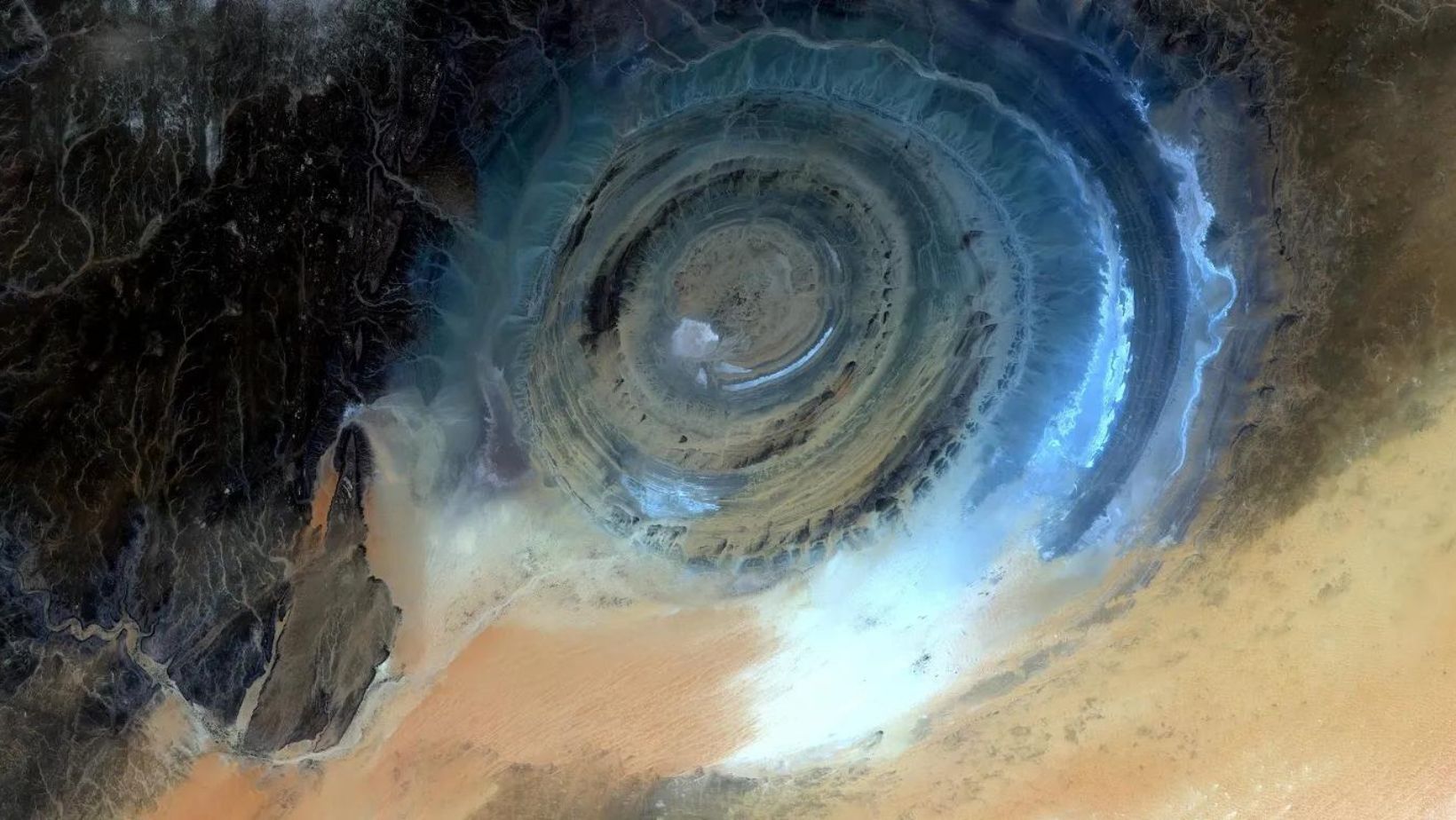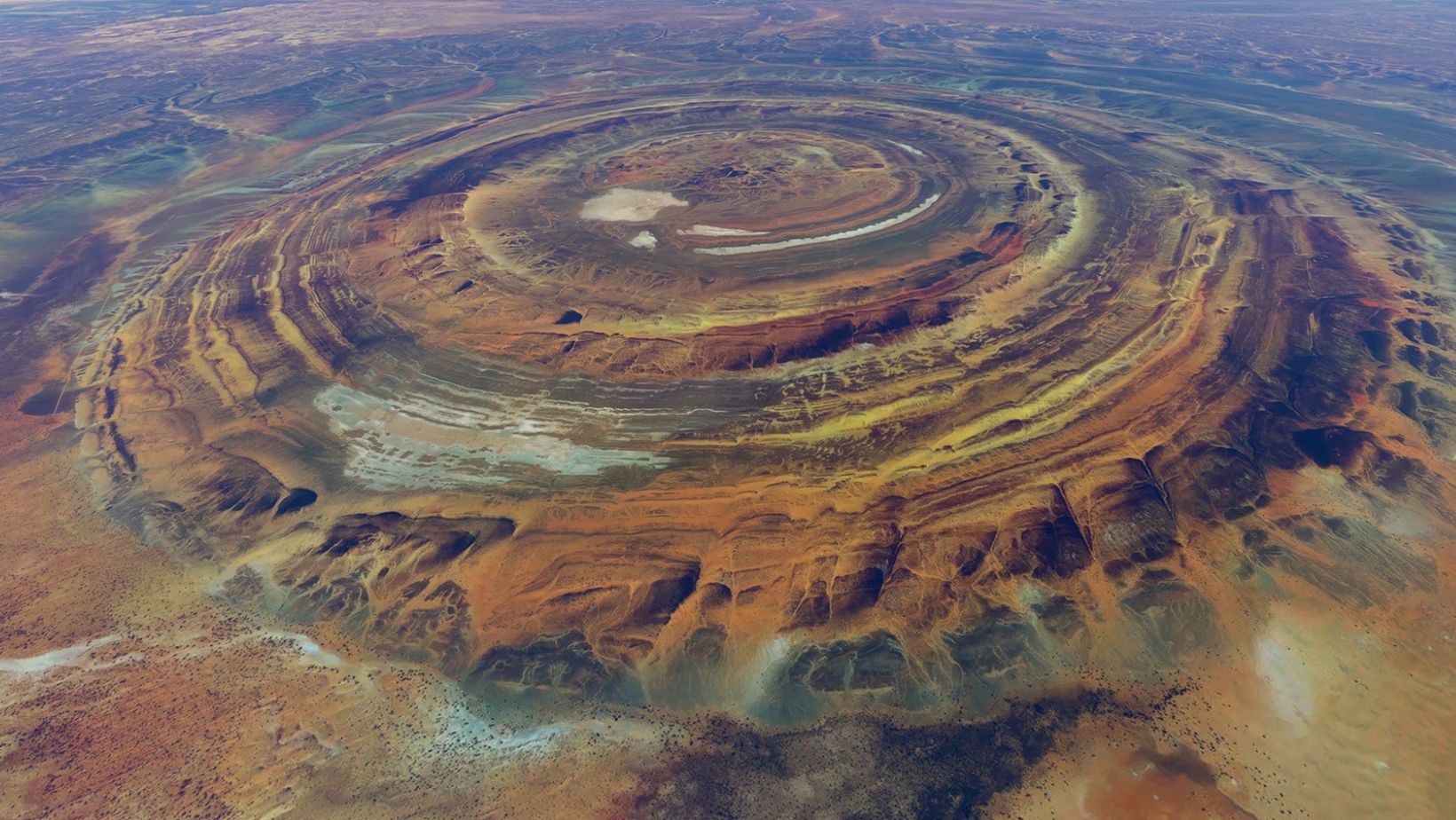Nestled in the heart of the Sahara Desert lies a geological marvel known as the Richat Structure. Often referred to as “The Eye of Sahara,” this stunning formation draws the gaze of travelers and scientists alike. From space, it resembles a giant eye, captivating all who see it. But what exactly is the Richat Structure, and how did it come to be? This mysterious wonder is not just a feast for the eyes; it holds secrets about Earth’s history and geology. Join us as we delve deeper into the enigma of the Eye of the Sahara and uncover its fascinating story.
What is the Richat Structure or Eye of Sahara?

The Richat Structure, also known as the Eye of the Sahara, is a prominent geological feature located in Mauritania. It spans approximately 50 kilometers (about 30 miles) in diameter, making it easily visible from space. The structure consists of concentric rings of exposed rock, which create a striking, eye-like appearance when viewed from above. These rings are composed of different types of rock, including limestone, sandstone, and granite.
Geologically, the Richat Structure is classified as a dome, formed by uplift and erosion processes over millions of years. It showcases distinct layers of sedimentary rock that have been shaped by wind and water. The central area is often filled with a variety of colors, ranging from beige to brown, adding to its visual allure.
Interestingly, while it looks like an impact crater, studies have shown that it is not a result of a meteorite strike. Instead, the formation is a natural geological phenomenon that provides insight into the Earth’s history and processes. Its unique characteristics and immense size make it a subject of fascination for both scientists and adventurers.
Geological Formation: Nature’s Design of Eye of Sahara
The Richat Structure was formed through a combination of geological processes over millions of years. Initially, it began as a sedimentary basin where layers of rock accumulated. Over time, tectonic forces caused the ground to uplift, creating a dome-like shape. Erosion then played a crucial role, wearing away softer rock layers and exposing the harder ones.
The structure showcases a series of concentric rings made up of various rock types. These rings are the result of differential erosion, where softer materials erode faster than harder ones. This process has revealed distinct layers, allowing scientists to study the geological history of the area.
Interestingly, despite its eye-like appearance, the Richat Structure is not a result of volcanic activity or meteorite impact. Instead, it is a natural feature formed through long-term geological processes. Today, it serves as a window into the Earth’s past, revealing insights about the region’s sedimentary history and the forces that shaped it. Its unique formation intrigues geologists and visitors alike, making it a captivating example of nature’s design.
Cultural Significance: Ancient Myths and Legends of Eye of Sahara

The Richat Structure, or Eye of the Sahara, has long captured the imagination of local cultures and communities. Various myths and legends have emerged around this geological wonder. Some believe it is the eye of a great giant, watching over the desert. Others think it is a portal to another world, a gateway for spirits.
In ancient times, the area surrounding the Richat Structure was home to nomadic tribes who viewed it as a significant landmark. It served as a navigational point, helping travelers cross the vast Sahara. The structure’s unique appearance and vastness made it an important cultural symbol for those living nearby.
Historically, the Richat Structure has been linked to trade routes that connected different regions of Africa. As such, it held economic significance as well, marking a critical juncture for caravans and traders. Today, it continues to be a point of interest, not just for scientists but also for tourists seeking to explore its beauty and cultural relevance.
The myths surrounding the Eye reflect humanity’s fascination with nature’s mysteries. They remind us of the connection between the environment and cultural identity, illustrating how geographical features can inspire stories and shape communities.
Scientific Investigations: Unraveling the Mystery of Eye of Sahara
Scientific investigations into the Richat Structure have aimed to unravel its geological mysteries. Researchers have used various methods, including satellite imagery, aerial surveys, and ground studies. These approaches help scientists analyze the structure’s formation and composition in detail.
Geological studies indicate that the Richat Structure is not an impact crater, as initially thought. Instead, it is a geological dome formed by erosion and uplift processes. The presence of concentric rings has provided insights into sedimentary processes in the Sahara. Researchers have found evidence of ancient marine environments, indicating that the region was once underwater.
Archaeological studies have also been conducted in the surrounding areas. These investigations have revealed ancient tools and artifacts, suggesting human presence for thousands of years. Such findings highlight the Richat Structure’s significance as a landmark for early cultures.
Additionally, the Richat Structure has become a valuable site for studying climate change. Scientists examine how environmental shifts have influenced the landscape over millennia. Overall, the Richat Structure serves as a crucial research site, providing valuable information about Earth’s geological history and human activity in the region.
Theories Surrounding the Richat Structure or Eye of Sahara
The Richat Structure has sparked numerous theories regarding its origin. Initially, many believed it to be an impact crater caused by a meteorite strike. This theory arose due to its circular shape and concentric rings. However, further research has debunked this idea, as no signs of shock metamorphism or impact-related materials were found.
The most widely accepted theory suggests that the Richat Structure is a geological dome. This formation occurred through a combination of uplift and erosion over millions of years. The softer rock layers eroded more quickly than the harder ones, creating the distinctive ringed appearance.
Another theory posits that the structure is the result of tectonic forces pushing the rock upwards. This process could have created the dome shape and allowed for the subsequent erosion to form the visible rings.
While these theories provide insight into the Richat Structure’s formation, some questions remain unanswered. Ongoing research continues to explore its geological history, making it a topic of interest for scientists. The Richat Structure serves as a fascinating case study in understanding Earth’s complex geological processes.
Modern Exploration: Adventurers and Researchers
Modern exploration of the Richat Structure has attracted adventurers and researchers alike. Notable expeditions have focused on mapping and studying the area to understand its geological features better. In the past few decades, these expeditions have utilized advanced technologies to enhance research capabilities.
Satellite imagery and aerial surveys have played a significant role in mapping the structure. These technologies allow researchers to analyze the landscape from various angles, revealing intricate details of the rings and layers. Geographic Information System (GIS) tools have also been employed to process spatial data, facilitating a deeper understanding of the structure’s formation. Eye of Sahara.
Ground investigations have involved teams of geologists and archaeologists conducting fieldwork in the area. They collect rock samples and artifacts to study the geological history and human activity linked to the Richat Structure. Such efforts have resulted in important findings about the environmental changes in the region over time.
Additionally, remote sensing technologies have been used to identify mineral compositions and sediment patterns. These modern techniques have significantly improved the accuracy of geological assessments. Overall, the combination of adventurers and researchers, along with cutting-edge technology, continues to shed light on the mysteries of the Eye of the Sahara. Eye of Sahara.
Ecological Importance: A Unique Habitat
The Richat Structure, or Eye of the Sahara, is not just a geological marvel; it also supports a unique ecosystem. The area around the structure features a variety of flora and fauna adapted to the arid desert environment. Vegetation primarily consists of hardy plants like acacias and various grasses that can withstand extreme conditions.
Wildlife in the region includes a range of species, from reptiles to small mammals. The structure’s unique features create microhabitats that offer refuge and resources for these animals. Birds, such as ostriches and various raptors, are commonly seen, taking advantage of the open spaces and varied terrain.
The Richat Structure plays a crucial role in the local ecosystem by providing a habitat for diverse species. Its distinctive geology influences water drainage and soil types, contributing to plant growth. These plants, in turn, support herbivores and, subsequently, predators. Eye of Sahara.
Additionally, the area serves as a migratory stop for birds traveling across the Sahara. The ecological importance of the Eye extends beyond its immediate surroundings, influencing regional biodiversity. Overall, the Richat Structure is a vital part of the local ecosystem, showcasing the interconnectedness of geology and ecology in the Sahara Desert.
Tourism and Accessibility: Visiting the Eye

Visiting the Richat Structure, or Eye of the Sahara, is an adventure for any traveler. Located in central Mauritania, it is accessible primarily by vehicle. The nearest town is Ouadane, about 45 kilometers (28 miles) away, which serves as a starting point for explorations. Many visitors choose to rent 4×4 vehicles due to the rugged terrain.
Travelers should prepare for the arid desert climate. The best time to visit is during the cooler months, from October to March, when temperatures are more manageable. Bringing plenty of water, food, and sun protection is essential. Local guides can enhance the experience, offering insights into the geology and cultural significance of the area.
Nearby attractions include the ancient town of Ouadane, a UNESCO World Heritage site known for its historic architecture. The surrounding Sahara Desert also provides opportunities for camel rides and stargazing. Travelers can immerse themselves in the rich culture of the region, interacting with local communities.
Overall, a visit to the Eye of the Sahara combines adventure, natural beauty, and cultural exploration, making it a unique destination for those seeking to experience the wonders of Mauritania. Eye of Sahara.
Conclusion: Eye of Sahara
The Richat Structure, or Eye of the Sahara, remains a captivating geological wonder with significant cultural, ecological, and scientific importance. Its unique formation has intrigued researchers, leading to various theories about its origins. Despite advancements in technology and exploration, many mysteries still surround this structure, leaving questions about its past and future. Ongoing research continues to uncover its geological history while also shedding light on its ecological role in the Sahara. As scientists explore further, the Eye promises to reveal even more secrets, ensuring its status as an enduring enigma that draws interest from around the world.
FAQs
What is the best time of year to visit the Richat Structure?
The best time to visit is during the cooler months, from October to March. During this period, temperatures are more comfortable for exploration. Visitors should also consider the weather conditions, as summer months can be extremely hot and challenging for outdoor activities.
Is there any accommodation available near the Richat Structure?
While there are limited accommodations directly near the Richat Structure, travelers can find options in nearby towns like Ouadane. Guesthouses and local hotels provide basic amenities for those looking to stay close to this geological wonder.
Are there guided tours available for visiting the Richat Structure?
Yes, guided tours are available and recommended for those unfamiliar with the area. Local guides can offer insights into the geology, history, and culture surrounding the Richat Structure, enhancing the overall experience for visitors.
What types of activities can visitors engage in while at the Richat Structure?
Visitors can engage in various activities, including hiking, photography, and exploring the unique geological features. Nearby, travelers may also enjoy camel rides, stargazing, and learning about the local culture from residents.
How has climate change impacted the Richat Structure and its surrounding environment?
Climate change has potential effects on the Richat Structure and its ecosystem. Changes in temperature and rainfall patterns can impact the flora and fauna in the region, as well as influence erosion processes. Ongoing research aims to monitor these changes and their long-term implications for the area.

